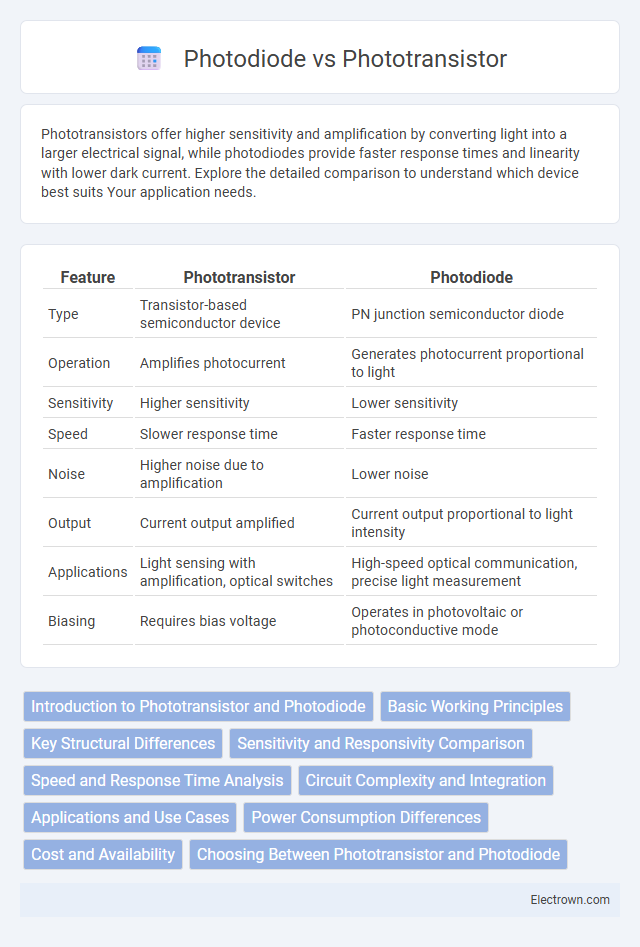Phototransistors offer higher sensitivity and amplification by converting light into a larger electrical signal, while photodiodes provide faster response times and linearity with lower dark current. Explore the detailed comparison to understand which device best suits Your application needs.
Table of Comparison
| Feature | Phototransistor | Photodiode |
|---|---|---|
| Type | Transistor-based semiconductor device | PN junction semiconductor diode |
| Operation | Amplifies photocurrent | Generates photocurrent proportional to light |
| Sensitivity | Higher sensitivity | Lower sensitivity |
| Speed | Slower response time | Faster response time |
| Noise | Higher noise due to amplification | Lower noise |
| Output | Current output amplified | Current output proportional to light intensity |
| Applications | Light sensing with amplification, optical switches | High-speed optical communication, precise light measurement |
| Biasing | Requires bias voltage | Operates in photovoltaic or photoconductive mode |
Introduction to Phototransistor and Photodiode
Phototransistors and photodiodes are semiconductor devices that convert light into electrical signals, each with unique characteristics suited for different applications. A photodiode operates by generating a current proportional to the incident light intensity, offering high-speed response and linearity, ideal for precise light detection. Phototransistors amplify the photocurrent internally, providing higher sensitivity and gain, making Your choice dependent on the required speed, sensitivity, and application environment.
Basic Working Principles
Phototransistors amplify current generated by light exposure using a transistor structure, producing a larger electrical output than photodiodes. Photodiodes operate by converting light into a small photocurrent directly through the photoelectric effect in a semiconductor junction. Phototransistors have slower response times and higher sensitivity, while photodiodes offer faster detection and linear output suitable for precise light measurements.
Key Structural Differences
Phototransistors and photodiodes differ primarily in their internal structure; phototransistors include a transistor with a base region activated by light, amplifying the photocurrent, whereas photodiodes consist of a simple p-n junction that generates current proportional to light intensity without amplification. The phototransistor's layered semiconductor design enables higher sensitivity but slower response time compared to the photodiode's compact and fast structure. Your choice depends on whether you need high gain and sensitivity (phototransistor) or fast, linear response (photodiode).
Sensitivity and Responsivity Comparison
Phototransistors generally exhibit higher sensitivity than photodiodes due to their internal current amplification, making them more suitable for detecting low light levels. Photodiodes offer faster response times and better linearity, with responsivity peaking typically around 0.6 to 0.7 A/W for silicon devices, while phototransistors may have responsivity values several times higher but with slower temporal resolution. Choosing between the two depends on the application requirements for sensitivity versus speed, as phototransistors trade off quicker response for enhanced responsivity.
Speed and Response Time Analysis
Phototransistors typically exhibit slower speed and longer response times compared to photodiodes due to the additional charge carrier amplification process involved. Photodiodes offer faster response times, often in the nanosecond range, making them ideal for high-speed applications such as optical communication and precise light detection. Your choice between these sensors should consider the required switching speed and timing accuracy for optimal performance in your specific application.
Circuit Complexity and Integration
Photodiodes offer simpler circuit designs due to their straightforward voltage or current output, making them ideal for integration in compact, low-power electronic devices. Phototransistors require additional components like resistors for biasing and amplification, increasing circuit complexity and board space. Photodiode integration is favored in high-speed, low-noise applications, whereas phototransistors suit applications demanding higher sensitivity but tolerate more complex circuitry.
Applications and Use Cases
Phototransistors are widely used in low-light sensing applications such as optical switches, position sensors, and digital light meters due to their high sensitivity and internal gain. Photodiodes excel in high-speed and precision applications like fiber optic communication, laser rangefinders, and medical imaging because of their fast response time and linearity. Both devices are integral in automation, safety systems, and environmental monitoring, selected based on the specific requirements for speed, sensitivity, and spectral response.
Power Consumption Differences
Phototransistors generally consume more power than photodiodes because they amplify the photocurrent internally, requiring a higher bias current. Photodiodes operate with lower power consumption due to their simpler structure and reverse-bias operation, making them ideal for energy-efficient applications. When optimizing your design for minimal power usage, selecting a photodiode is often more advantageous than a phototransistor.
Cost and Availability
Photodiodes are generally more cost-effective and widely available due to their simpler design and extensive use in consumer electronics. Phototransistors tend to be more expensive, reflecting their enhanced sensitivity and internal gain which suits specialized applications. Both components can be sourced easily from major electronic component suppliers such as Digi-Key, Mouser, and Arrow Electronics.
Choosing Between Phototransistor and Photodiode
Choosing between a phototransistor and a photodiode depends on sensitivity and response speed requirements. Phototransistors offer higher sensitivity and current gain, making them suitable for low-light detection, while photodiodes provide faster response times and better linearity for precise light measurement. Your application's need for speed or sensitivity will guide the optimal choice between these two semiconductor light sensors.
Phototransistor vs Photodiode Infographic

 electrown.com
electrown.com